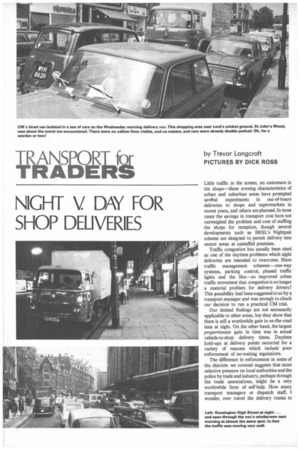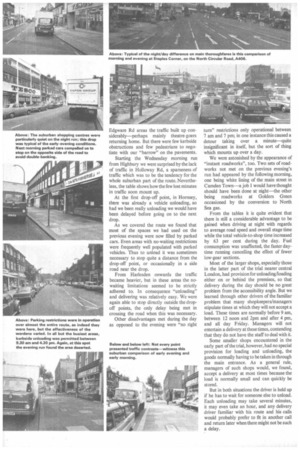Jr UNA 6 61i4
Page 48

Page 49

Page 50

If you've noticed an error in this article please click here to report it so we can fix it.
NIGHT V DAY FOR SHOP DELIVERIES
by Trevor Longcroft PICTURES BY DICK ROSS Little traffic in the streets, no customers in the shops—these evening characteristics of urban and suburban areas have prompted sevdral experiments in out-of-hours deliveries to shops and supermarkets in recent years, and others are planned. In most cases the savings in transport cost have not outweighed the problem and cost of staffing the shops for reception, though several developments such as BRSL's Nightpak scheme are designed to permit delivery into secure areas at unstaffed premises.
Traffic congestion has usually been cited as one of the daytime problems which night deliveries are intended to overcome. Have traffic management schemes—one-way systems, parking control, phased traffic lights and the like—so improved urban traffic movement that congestion is no longer a material problem for delivery drivers? This possibility had been suggested to us by a transport manager and was enough to clinch our decision to run a practical CM trial.
Our limited findings are not necessarily applicable to other areas, but they show that there is still a worthwhile gain in on-the-road time at night. On the other hand, the largest proportionate gain in time was in actual vehicle-to-shop delivery times. Daytime hold-ups at delivery points occurred for a variety of reasons which include poor enforcement of no-waiting regulations.
The difference in enforcement in some of the districts we covered suggests that more selective pressure on local authorities and the police by trade and industry, perhaps through the trade associations, might be a very worthwhile form of self-help. How many transport managers or dispatch staff, I wonder, ever travel the delivery routes to see how conditions are changing?
The general findings above were, on our necessarily small-scale experiment, confirmed by the stopwatch figures. Making simulated deliveries to 20 shops on a 35mile route took 3hr. 3rnin. on a Wednesday morning, starting at 9.36 a.m., of which 2hr. 48min. was actual running time. On the Tuesday evening starting at 7.35 p.m. the same run had taken 2hr. 28min., of which 2hr. 18min. was actually on the move.
And there are more aspects to consider than are at first apparent. At night, not only is traffic lighter but the driver has less physical work to do. For example, we used a gearchange counter with the Bedford TK van we had hired from Capon for the trial, and found that even our short route required 75 more gearchanges on the daytime run392 as against 317. This has a bearing on component life and repair costs as well as driver fatigue. As might be expected, the biggest daytime increase in gearchanging occurred in the busier places, such as Kensington High Street, and the use of pedestrian crossings was a noticeable factor, comparing night with day.
The 5or 6-ton boxvan is a typical modern delivery vehicle, so we hired a 6-tonner and loaded it with 1 ton of sandbags which remained in place throughout the trial. We had established that on many typical delivery rounds-with, say, bread and cakes-a vehicle of this size carried bulky but light payloads, of not much more than 2 tons. And since we could not actually deliver to shops at night we decided to simulate all deliveries and to run with the vehicle at around the mean (half-distance) payload throughout. Operators with full-weight loads would, of course, find mpg and gearchange frequency affected accordingly.
To simulate deliveries we halted the van at the nearest legally permissible point to each shop, and paced out a single trip to and from the shop with our imaginary drop. The table shows the detailed timings, which are only intended to indicate the comparative night/day parking and pavement-crossing situation. It is assumed that actual unloading -opening the van, loading the barrowwould be the same night and day, and this time would need to be added.
We selected a route, as a delivery driver knowing his area might do, to link the 20 shops we intended to visit. Starting with Highbury Corner (Holloway Rd) as our "depot" the route went westwards across North London suburbs-Hampstead, Finchley, Golders Green, Hendon, Neasden and Harlesden-then curved south into Kensington, Edgware Rd, St. John's Wood and Camden Town, where heavier traffic conditions could be expected.
Making the evening run first we started from Highbury at 7.35 p.m. and encountered few difficulties. In most cases-except where it was dangerous to do so-we were able to park outside the drop-off point without hindrance to other road users or infringement of the law.
The initial stops, mainly suburban, gave little trouble and there was little or no traffic. However, as drops progressed and we turned towards the Kensington High St and Edgware Rd areas the traffic built up considerably—perhaps mainly theatre-goers returning home. But there were few kerbside obstructions and few pedestrians to negotiate with our "barrow" on the pavements.
Starting the Wednesday morning run from Highbury we were surprised by the lack of traffic in Holloway Rd, a sparseness of traffic which was to be the tendency for the whole suburban part of the route. Nevertheless, the table shows how the few lost minutes in traffic soon mount up.
At the first drop-off point, in Hornsey, there was already a vehicle unloading, so had we been really unloading we would have been delayed before going on to the next drop.
As we covered the route we found that most of the spaces we had used on the previous evening were now filled by parked cars. Even areas with no-waiting restrictions were frequently well populated with parked vehicles. Thus to unload it was sometimes necessary to stop quite a distance from the drop off point, or occasionally in a side road near the drop.
From Harlesden onwards the traffic became heavier, but in these areas the nowaiting limitations seemed to be strictly adhered to. In consequence "unloading" and delivering was relatively easy. We were again able to stop directly outside the dropoff points, the only delay being met in crossing the road when this was necessary.
Other disadvantages met during the day as opposed to the evening were "no right turn" restrictions only operational between 7 am and 7 pm; in one instance this caused a detour taking over a minute—quite insignificant in itself, but the sort of thing which mounts up over a day.
We were astonished by the appearance of "instant roadworks", too. Two sets of roadworks not met on the previous evening's run had appeared by the following morning, one being white lining of the main street in Camden Town—a job I would have thought should have been done at night—the other being roadworks at Golders Green occasioned by the conversion to North Sea gas.
From the tables it is quite evident that there is still a considerable advantage to be gained when driving at night with regards to average road speed and overall stage time while the total vehicle-to-shop time increased by 63 per cent during the day. Fuel consumption was unaffected, the faster daytime running cancelling the effect of fewer low-gear sections.
Most of the larger shops, especially those in the latter part of the trial nearer central London, had provision for unloading/loading either on or behind the premises, so that delivery during the day should be no great problem from the accessibility angle. But we learned through other drivers of the familiar problem that many shopkeepers/managers stipulate times at which they will not accept a load. These times are normally before 9 am, between 12 noon and 2pm and after 4 pm, and all day Friday. Managers will not entertain a delivery at these times, contending that they do not have the staff to deal with it.
Some smaller shops encountered in the early part of the trial, however, had no special provision for loading and unloading, the goods normally having to be taken in through the main entrance. As a general rule, managers of such shops would, we found, accept a delivery at most times because the load is normally small and can quickly be stored.
But in both situations the driver is held up if he has to wait for someone else to unload. Each unloading may take several minutes, it may even take an hour, and any delivery driver familiar with his route and his calls would probably prefer to fit in another call and return later when there might not be such a delay.












































































































































